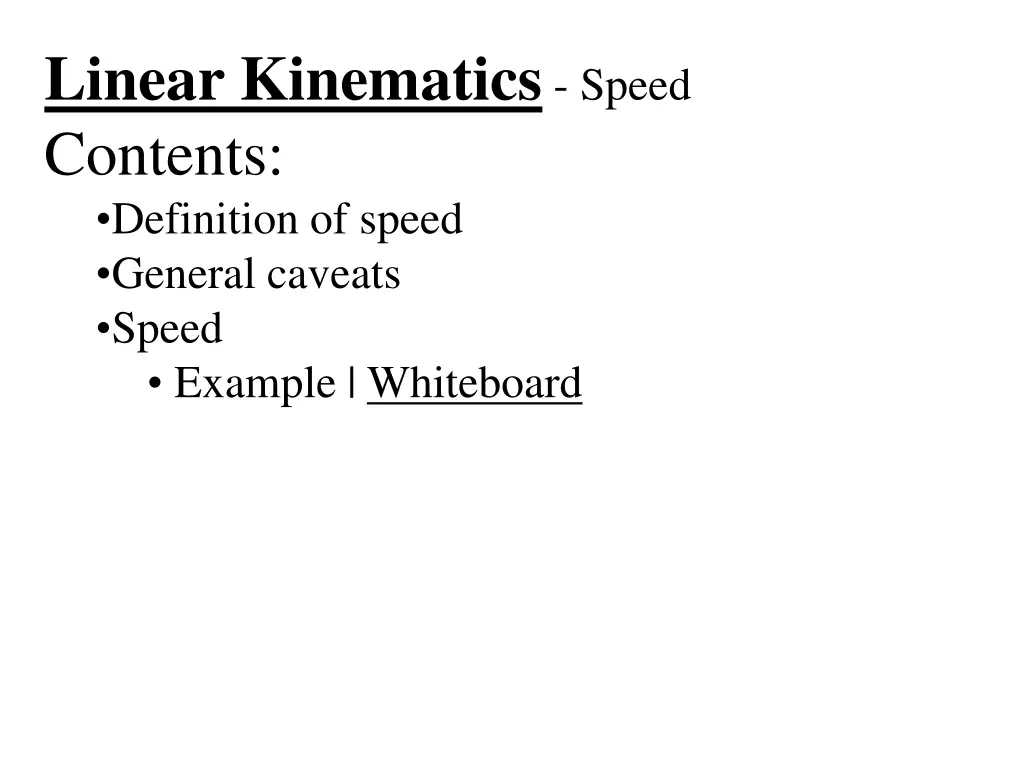
Understanding Linear Kinematics: Speed Concepts
Explore the fundamental concepts of speed in linear kinematics, including the definition of speed, average speed calculations, and practical examples. Utilize the provided formulas and examples to grasp the relationship between distance, time, and speed in various scenarios.
Uploaded on | 0 Views
Download Presentation

Please find below an Image/Link to download the presentation.
The content on the website is provided AS IS for your information and personal use only. It may not be sold, licensed, or shared on other websites without obtaining consent from the author. If you encounter any issues during the download, it is possible that the publisher has removed the file from their server.
You are allowed to download the files provided on this website for personal or commercial use, subject to the condition that they are used lawfully. All files are the property of their respective owners.
The content on the website is provided AS IS for your information and personal use only. It may not be sold, licensed, or shared on other websites without obtaining consent from the author.
E N D
Presentation Transcript
Linear Kinematics - Speed Contents: Definition of speed General caveats Speed Example | Whiteboard
Speed the rate of motion Our First Formula! vavg = x/ t vavg - average speed x, x - distance t, t - elapsed time (m/s, f/s, mph, km/hr) (m, cm, feet, miles, km) (seconds, minutes, hours) Use math to solve for x and t (triangle of mystery) The units must match!
Example: A winch moves a cable 12.5 cm per second. What time will it take to reel in 15 m of cable? First, 12.5 cm/s = .125 m/s, so x = 15 m vavg = .125 m/s The units match, so now just solve: t = 15 m/.125 m/s = 120 seconds vavg = x/ t
Whiteboards: (for no calculators) Speed 1 | 2 | 3 | 4 | 5 For Calculators click here
How fast are you going if you run 27.0 m in 3.0 seconds? v = x/t v = (27.0 m)/(3.0 s) = 9.0 m/s 9.0 m/s
In what time will a car that is traveling 88.0 f/s go 22 feet? v = x/t 88.0 f/s = (22 f)/t t = (22 f )/(88.0 f/s) = .25 s .25 s
If you are in a car that is going 30 m/s and you look to the side for 6.0 seconds. How far does the car travel in that time? v = x/t 30 m/s = x/(6.0 s) x = (6.0 s)(30 m/s) = 180 m 180 m
What time (in days) will it take a glacier that moves 25.0 feet/day to travel 100. yards? 100. yards = 300. feet v = x/t 25.0 f/day = (300 f)/t t = (300 f)/(25.0 f/day) = 12 days 12 days
What speed must an elevator have if it is to climb 10. floors in 15 seconds? Each story is 3.0 m tall. s = (10. floors)(3.0 m/floor) = 30 m v = x/t v = (30 m)/(15 s) = 2.0 m/s 2.0 m/s 2.0 m/s
A winch takes up 12.0 cm of cable a second. What time will it take to reel up 36.0 m of cable? 12.0 cm/s = .120 m/s (make units match) v = x/t .120 m/s = (36.0 m)/t t = 300 s 300. s 300. s
Whiteboards: (Calculators) Speed 1 | 2 | 3 | 4 | 5
How fast are you going if you run 27.0 m in 3.2 seconds? vavg = x/ t vavg = 27.0 m/3.2 s = 8.4 m/s 8.4 m/s
In what time will a car that is traveling 95.3 f/s go 13.45 feet? vavg = x/ t 95.3 f/s = 13.45 f/ t t = 13.45 f /95.3 f/s = .141 s .141 s
How far will a bullet traveling 350 m/s go in 6.34 seconds? vavg = x/ t 350 m/s = x/6.34 s x = (350 m/s)(6.34 s) = 2200 m 2200 m
A car traveling 80. km/hr will go how far (in meters) in 2.7 seconds? 1000 m = 1 km 3600 s = 1 hour (60x60) 80. km/hr(1000m/km) = 80,000 m/h 80,000 m/h/(3600s/h) = 22.22222 m/s vavg = x/ t 22.22222 m/s = x/2.7 s x = (22.22222 m/s)(2.7 s) = 60 m 60 m
What time (in days) will it take a glacier that moves 15.6 feet/day to travel 100 yards? 100 yards = 300 feet vavg = x/ t 15.6 f/day = 300 f/ t t = 300 f/15.6 f/day = 19.2 days 19.2 days
